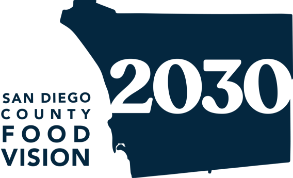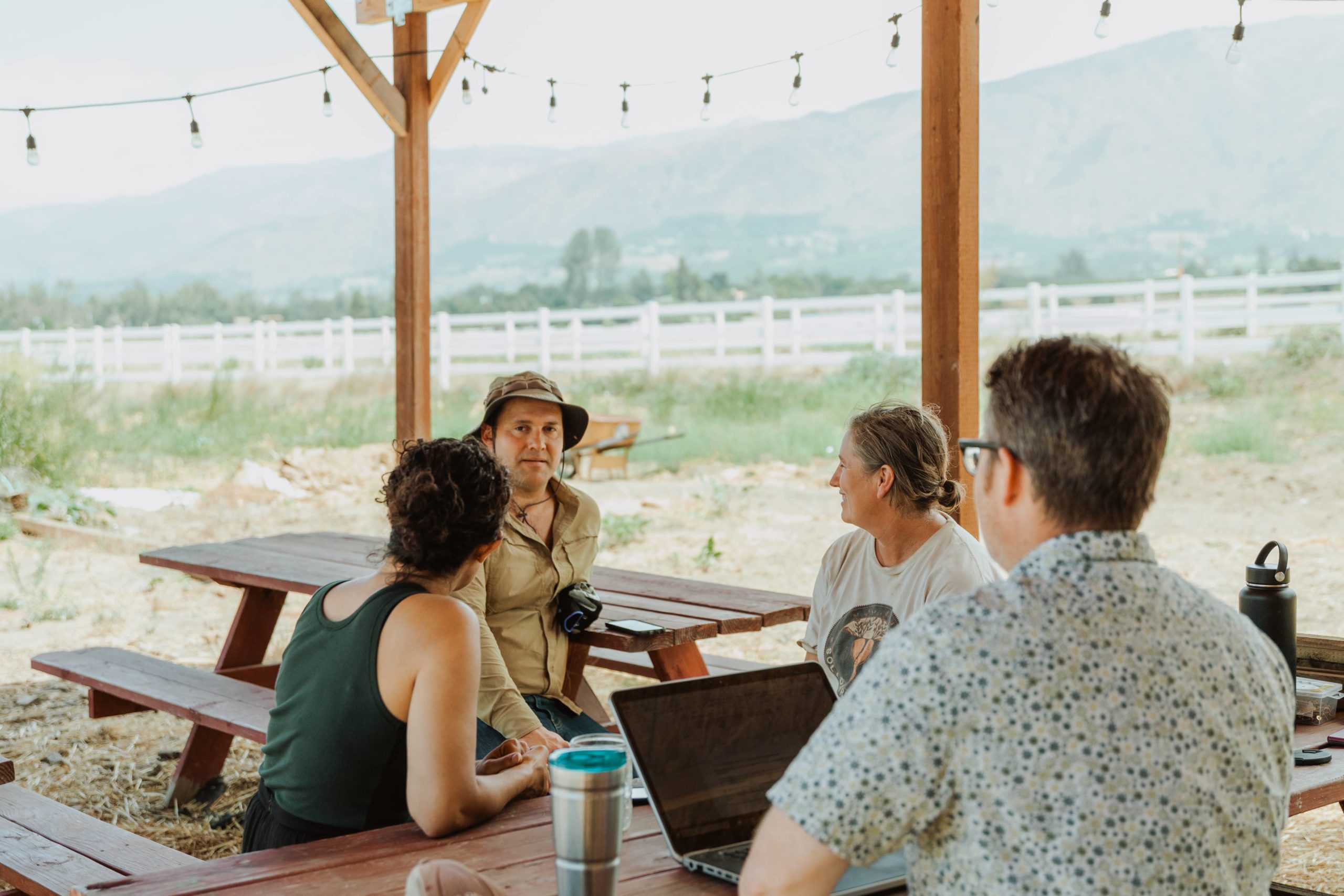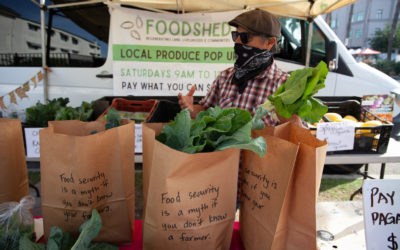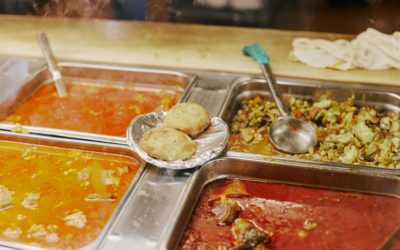Becoming a subscriber to Foodshed’s Fresh 5 program—a weekly distribution of fresh, seasonal produce, grown by the small farmers who make up the Foodshed cooperative—means you’re in for two surprises with every delivery. One is the produce itself: an ever-changing...
Food Vision 2030 Glossary
In this glossary, we have gathered the definitions of key terms and concepts that are referenced throughout Food Vision 2030.
Agricultural Land Trust
Preserves agricultural land by acquiring conservation easements that permanently restrict nonagricultural development. Land trusts help to keep farmland in active production, and ensure affordable land access for the next generation of farmers.
Aquaculture
The controlled process of breeding, rearing, and harvesting fish, shellfish, algae, and other aquatic organisms. This method, often known as fish farming, is used to produce food and commercial products, restore habitats, replenish wild stocks, and rebuild endangered populations.
B
BIPOC
Black, Indigenous, and People of Color. This acronym is used to describe Black, Latinx, Indigenous, Asian, Hawai’ian and Pacific Islander, North African, Southwest Asian/Middle Eastern and other non-white members of the community.
Bycatch
Refers to fish or other marine species that are caught unintentionally, while fishing for a specific species or ‘target catch’. Bycatch occurs when other species are attracted to bait and/or target catch, and are incidentally brought up with the catch or trapped in fishing gear.
C
CalFresh/SNAP or Food Stamps
Supplemental Nutrition Assistance Program (SNAP): largest federal nutrition assistance program for needy families to assist in the purchase of food. Known as CalFresh in the state of California. Previously, benefits were provided in the form of physical coupons, leading the program to become known informally as “food stamps”. Today, nutrition benefits are provided electronically through an EBT card.
Cap and Trade
Government regulatory program designed to reduce pollution in our atmosphere, by establishing a cap on major sources of GHG emissions, and creating economic incentives for investment in cleaner, more efficient technologies.
Carbon Farming
Agricultural practices that remove CO2 from the atmosphere (carbon sequestration), storing it in soil and plant matter. These practices are aimed at mitigating climate change by offsetting greenhouse gas emissions. Examples of carbon farming practices include planting cover crops, installing hedgerows, practicing no or low till farming, and applying composting.
Carbon Sequestration
Carbon sequestration is the process of capturing and storing atmospheric carbon dioxide. It is one method of reducing the amount of carbon dioxide in the atmosphere with the goal of reducing global climate change (USGS).
Climate Change
Climate change refers to significant changes in global temperature, precipitation, wind patterns and other measures of climate that occur over several decades or longer. Evidence suggests many of these extreme climate changes are connected to rising levels of carbon dioxide and other greenhouse gases in the Earth’s atmosphere — more often than not, the result of human activities (UC Davis).
Commodity Crops
Crops regulated by the USDA, usually grown in large volumes, for the purpose of sale to the commodities market (rather than for consumption or processing). Many commodity crops re-enter the industry as oils, sweeteners, filler, or animal feed. The most common commodity crops grown in the US are corn, soybeans and wheat.
Composting
Recycling organic waste into nutrient rich fertilizer used to enrich soil. Composting is the fifth tier on the EPA Food Recovery Hierarchy, and provides a solution for inedible food scraps or food waste that could not be addressed through source reduction or redistribution. Composting is also a carbon farming practice.
Conservation Easements
A voluntary, legal agreement that permanently limits uses of the land in order to protect its conservation values (National Conservation Easement Database).
Culturally Appropriate Food
Food that corresponds to individual and/or collective demand and preferences, shaped by one’s racial, ethnic, religious, linguistic, or social backgrounds. Culturally appropriate food is defined and redefined by the individual and/or collective.
E
EBT
Electronic Benefit Transfer (EBT) Card utilized by CalFresh recipients to pay for food. CalFresh and cash aid benefits are deposited electronically, and cards can be used like a Debit/ATM card at any Supplemental Nutrition Assistance Program (SNAP) authorized business that accepts EBT.
Economies of Scale
Cost advantages or savings that occur when production is scaled up, traditionally achieved by large corporations with significant buying power. Economies of scale typically occur when the cost per unit decreases as the output increases.
F
Federal Poverty Level (FPL)
A measure of income used to determine eligibility for federal, state, and local programs and benefits. Typically categorized as either poverty thresholds, used statistically to estimate the number of Americans living in poverty; or poverty guidelines, used administratively to determine financial eligibility for programs and benefits. Poverty guidelines are sometimes represented in percentage multiples (e.g. 125% FPL) to increase accessibility and eligibility for certain federal assistance programs (e.g. Medicaid, SNAP).
Food Environment (or Community Food Environment)
The physical, economic, political, and socio-cultural conditions in which people access food within their community. These conditions impact and shape how people make decisions about food.
Food Hub
Facilities that aggregate, store, process, distribute, and/or market food from local and regional producers to reach markets of all types and scales, including individuals, restaurants, retailers, and institutions.
Food System
A food system is an interconnected web of activities, resources, and people involved in keeping us healthy and nourished. It includes the production, processing, packaging, distribution, marketing, consumption, and disposal of food. The food system reflects and responds to social, cultural, political, economic, health, and environmental conditions, and can be identified at multiple scales, from a household kitchen to a city, county, state, or nation.
Food Sovereignty
“Food sovereignty is the right of peoples to healthy and culturally appropriate food produced through ecologically sound and sustainable methods, and their right to define their own food and agriculture systems. It puts the aspirations and needs of those who produce, distribute and consume food at the heart of food systems and policies rather than the demands of markets and corporations.”
–Declaration of Nyéléni, the first global forum on food sovereignty, Mali, 2007
G
Gleaning
Collection and donation of excess produce from farms, gardens, farmer’s markets, grocers, and private residences. Gleaning is a form of food recovery, and excess food is donated to food pantries, food banks, and communities in need.
H
Heirs’ Property Law
Property passed to family members by inheritance, usually without a will, or without an estate planning strategy. Typically, it is created when land is passed from someone who dies “intestate,” meaning without a will, to their spouse, children, or others who may be legally entitled to the property (Center for Agriculture & Food Systems). Heirs’ property is most predominant among Black landholders in the South and has been a significant driver of Black land loss in the United States.
I
Integrated Nutrition Security System
Coined by the Rockefeller Foundation, a system combining nutrition and food security, ensuring that all people have dignified access to affordable, healthy, and culturally appropriate food. It treats access to healthy food as a right, making it a core element of health and education.
P
Philanthropic redlining
The chronic underfunding of BIPOC-led organizations in the United States (Black Social Change). This discriminatory practice is when philanthropic funds are inequitably distributed, with Black-led organizations being significantly underfunded in comparison to white-led organizations. These practices are rooted in unconscious biases on the side of funders, and perpetuated stereotypes/narratives of Black-led organizations’ capacity to administer funds.
R
Redlining
Discriminatory practices and housing policies in which loans are denied, or services are restricted, in Black and Brown neighborhoods. The term redlining comes from the practice of using red marks on maps to identify African-American neighborhoods, and nearby neighborhoods, that were high risk for lenders. The Home Owners Loan Corp. and The Federal Housing Administration (est. 1934) were the first to institutionalize these practices of segregation, by refusing mortgages in and near Black neighborhoods.
Reparations
The act of making amends, or to right a wrong. Reparations are a system of redress for historical injustices. In the United States, reparations have been provided to Indigenous peoples and Japanese Americans who have experienced egregious injustices at the hands of the federal government. Black Americans have yet to receive reparations for slavery.
S
Source Reduction
Top strategy on the EPA Food Recovery Hierarchy for the elimination and diversion of wasted food. Also known as food waste prevention, it involves strategies to prevent the creation of food waste from the onset.
Specialty Crops
Defined by the USDA, and refers to fruits and vegetables, tree nuts, dried fruit, horticulture, and nursery crops.
U
Union Busting
Legal and illegal activities undertaken, by an employer or consultant, to prevent employees from exercising their right to organize (i.e. forming a union, growing union membership).
V
Values-based Procurement
Food procurement practices or purchasing decisions driven by values rooted in local food economies, health and nutrition, sustainability, and welfare. The Good Food Purchasing Program is one example of a values-based food procurement framework built around five core values—local economies, environmental sustainability, valued workforce, animal welfare, and nutrition.





